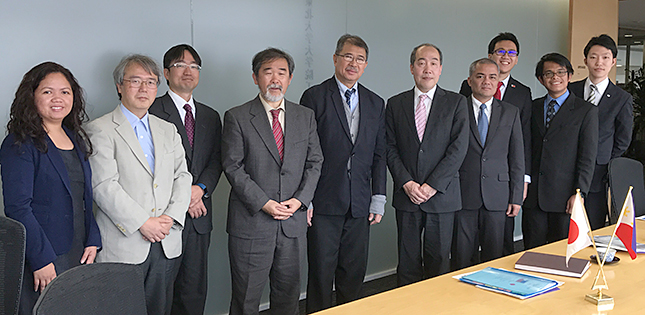There was a special guest at the Graduate School of Engineering's graduation ceremony at Hagi Hall on March 24. Fortunato de la Pena, the Secretary of the Department of Science and Technology of the Philippines was on hand to congratulate two Filipino government scholars who graduated that day.
The students - Ariston Nicolas Gonzalez and John Leur Delos Santos Labrador - each received a Masters of Science in Aerospace Engineering. Both played in big role in the development of the DIWATA-1 microsatellite in 2016, a collaboration between the Philippines government, Tohoku University and Hokkaido University. The microsatellite was the first major achievement of the Philippines' new space technology development programme.
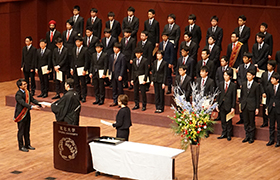
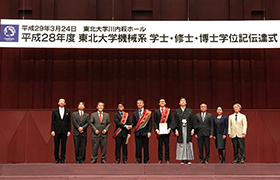
"They are pioneers and I am very proud of them," said Secretary de la Pena about Gonzales and Labrador. "At the moment, we don't have enough people with the right expertise in the Philippines, so the training that the students get here in Japan will play an important role in crafting the future of our programme."
The DIWATA-1 is equipped with imaging sensors of four different fields-of-view, and was designed to provide remote sensing information that can help the Philippines spot devastating meteorological events and better understand the environmental issues affecting the islands.
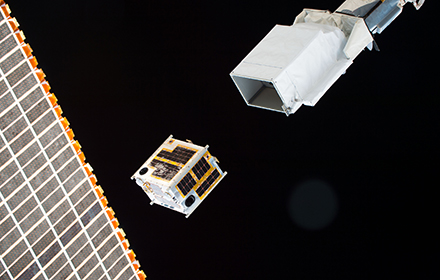
Since its orbital insertion from the International Space Station on April 27, 2016, DIWATA-1 has provided useful Earth imaging data, which has been downloaded to a ground station in the Philippines for scientific analysis.
"When DIWATA-1 was launched a year ago, it caught the imagination of the people in my country," said Secretary de la Pena. "Not only the decision makers but ordinary people too, became interested in it. It's the beginning of something very exciting."
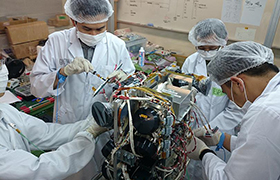
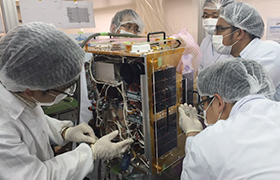
"Building a satellite that works properly in the harsh space environment is not an easy task," said Professor Kazuya Yoshida. "DIWATA-1 would not have been possible if not for the many, many hours of hard work put in by Gonzalez, Labrador and all the students involved in the project. Based on the lessons and feedback from that first satellite, DIWATA-2 is now under development, and will have even more advanced capabilities."
DIWATA-2 - which remains a 3-way collaboration with Hokkaido University - is expected to be ready for launch in 2018.
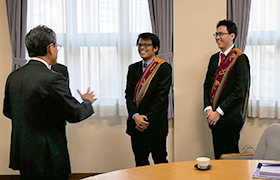
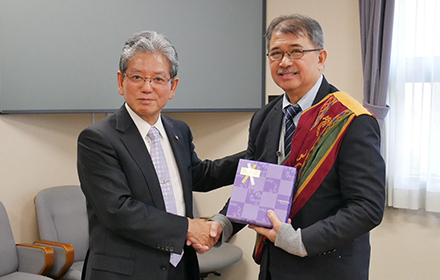
Following the graduation ceremony, Secretary de la Pena and the Philippine delegation - including the students Gonzales and Labrador - met with Tohoku University President Susumu Satomi.
The president congratulated the students on their graduation as well as their pioneering work on the Philippines' first microsatellite. He encouraged them to use the university's alumni network to continue to be creative and innovative.
Secretary de la Pena, speaking highly of the training his students received at Tokohu University, expressed hope that continued collaboration will lead his government's space development programme to new heights.
The delegation also spoke briefly about the Asian Micro-satellite Consortium (AMC) set up last November to develop microsatellite technologies. AMC comprises 16 space agencies and universities from nine Asian nations, including Tohoku University and the Philippines.
"Our dream is to have a network of operations with Tohoku University as a hub for advanced satellite technology expertise," said Yoshida. "We are very keen to help educate and foster young space engineers."
For enquiries about this article:
Public Relations Division, Tohoku UniversityEmail: public_relations@grp.tohoku.ac.jp
For enquires about the microsatellite programme:
Professor Kazuya YoshidaTohoku University Graduate School of Engineering
Tel: +81-22-795-6992
Email: yoshida astro.mech.tohoku.ac.jp

